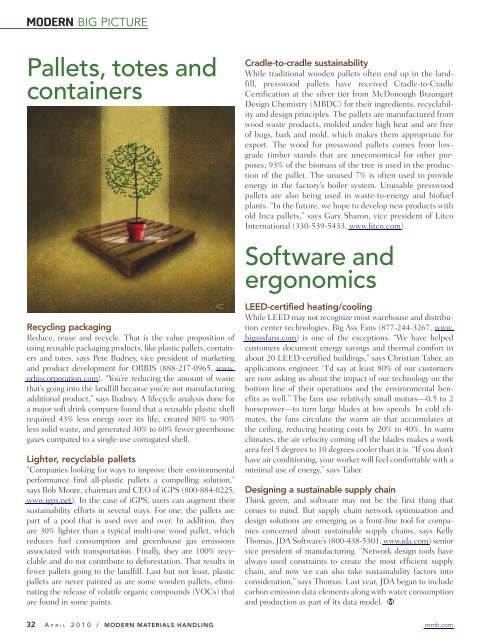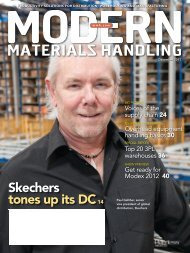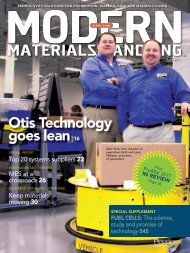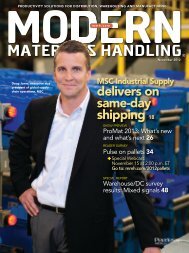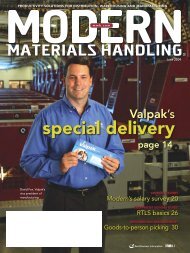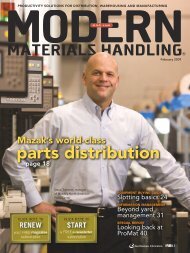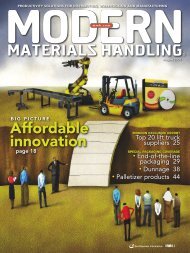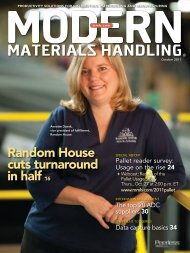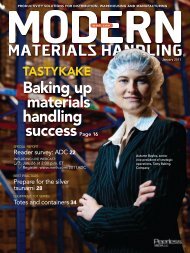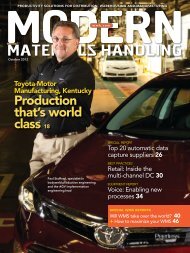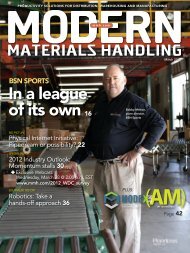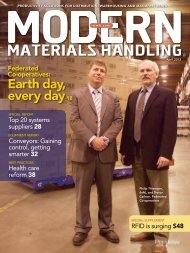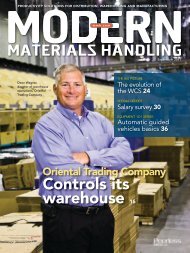Modern Materials Handling - April 2010
Modern Materials Handling - April 2010
Modern Materials Handling - April 2010
- No tags were found...
Create successful ePaper yourself
Turn your PDF publications into a flip-book with our unique Google optimized e-Paper software.
BIG PICTUREPallets, totes andcontainersRecycling packagingReduce, reuse and recycle. That is the value proposition ofusing reusable packaging products, like plastic pallets, containersand totes, says Pete Budney, vice president of marketingand product development for ORBIS (888-217-0965, www.orbiscorporation.com). “You’re reducing the amount of wastethat’s going into the landfill because you’re not manufacturingadditional product,” says Budney. A lifecycle analysis done fora major soft drink company found that a reusable plastic shellrequired 43% less energy over its life, created 80% to 90%less solid waste, and generated 30% to 60% fewer greenhousegases compared to a single-use corrugated shell.Lighter, recyclable pallets“Companies looking for ways to improve their environmentalperformance find all-plastic pallets a compelling solution,”says Bob Moore, chairman and CEO of iGPS (800-884-0225,www.igps.net). In the case of iGPS, users can augment theirsustainability efforts in several ways. For one, the pallets arepart of a pool that is used over and over. In addition, theyare 30% lighter than a typical multi-use wood pallet, whichreduces fuel consumption and greenhouse gas emissionsassociated with transportation. Finally, they are 100% recyclableand do not contribute to deforestation. That results infewer pallets going to the landfill. Last but not least, plasticpallets are never painted as are some wooden pallets, eliminatingthe release of volatile organic compounds (VOCs) thatare found in some paints.Cradle-to-cradle sustainabilityWhile traditional wooden pallets often end up in the landfill,presswood pallets have received Cradle-to-CradleCertification at the silver tier from McDonough BraungartDesign Chemistry (MBDC) for their ingredients, recyclabilityand design principles. The pallets are manufactured fromwood waste products, molded under high heat and are freeof bugs, bark and mold, which makes them appropriate forexport. The wood for presswood pallets comes from lowgradetimber stands that are uneconomical for other purposes;93% of the biomass of the tree is used in the productionof the pallet. The unused 7% is often used to provideenergy in the factory’s boiler system. Unusable presswoodpallets are also being used in waste-to-energy and biofuelplants. “In the future, we hope to develop new products withold Inca pallets,” says Gary Sharon, vice president of LitcoInternational (330-539-5433, www.litco.com).Software andergonomicsLEED-certified heating/coolingWhile LEED may not recognize most warehouse and distributioncenter technologies, Big Ass Fans (877-244-3267, www.bigassfans.com) is one of the exceptions. “We have helpedcustomers document energy savings and thermal comfort inabout 20 LEED-certified buildings,” says Christian Taber, anapplications engineer. “I’d say at least 80% of our customersare now asking us about the impact of our technology on thebottom line of their operations and the environmental benefitsas well.” The fans use relatively small motors—0.5 to 2horsepower—to turn large blades at low speeds. In cold climates,the fans circulate the warm air that accumulates atthe ceiling, reducing heating costs by 20% to 40%. In warmclimates, the air velocity coming off the blades makes a workarea feel 5 degrees to 10 degrees cooler than it is. “If you don’thave air conditioning, your worker will feel comfortable with aminimal use of energy,” says Taber.Designing a sustainable supply chainThink green, and software may not be the first thing thatcomes to mind. But supply chain network optimization anddesign solutions are emerging as a front-line tool for companiesconcerned about sustainable supply chains, says KellyThomas, JDA Software’s (800-438-5301, www.jda.com) seniorvice president of manufacturing. “Network design tools havealways used constraints to create the most efficient supplychain, and now we can also take sustainability factors intoconsideration,” says Thomas. Last year, JDA began to includecarbon emission data elements along with water consumptionand production as part of its data model.32 A P R I L 2 0 1 0 / MODERN MATERIALS HANDLING mmh.com


